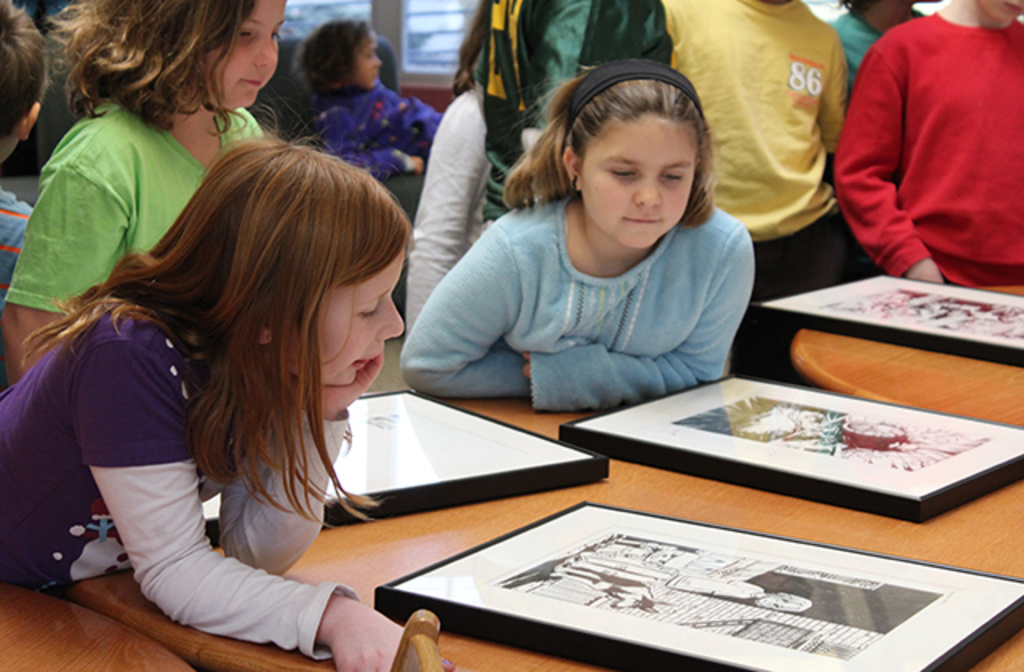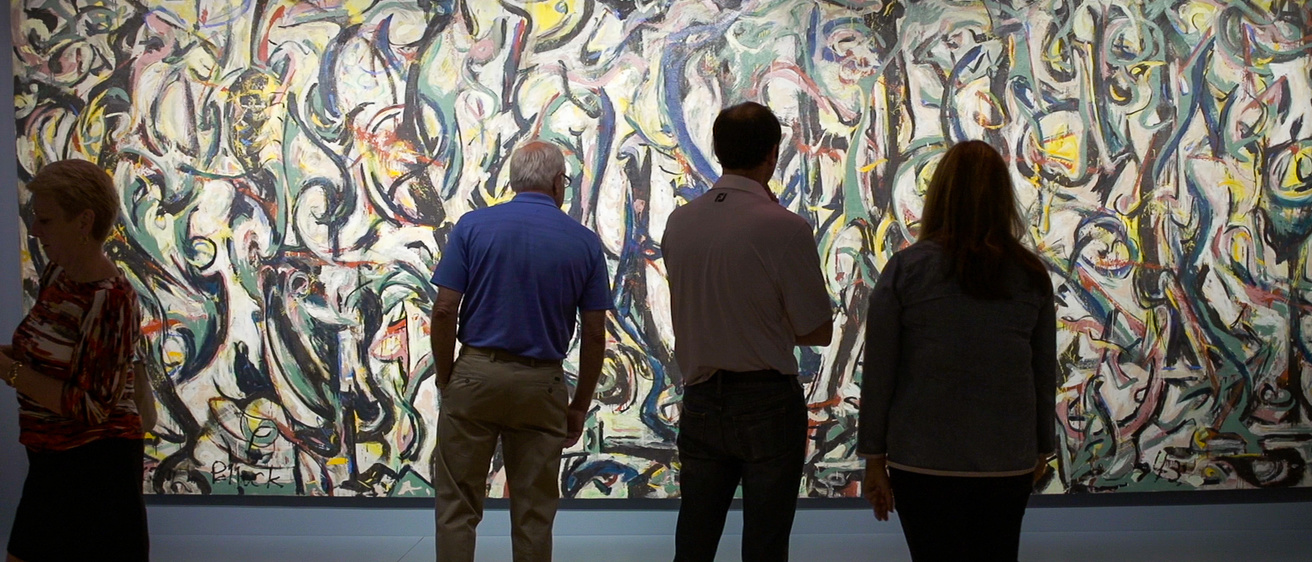Since June 2008, the University of Iowa Museum of Art (UIMA) has been a museum without a home. Though it has faced many challenges since floodwaters forced the UIMA from its original building along the Iowa River, officials have found a way for the museum to thrive while thinking—and living—outside the box.
Kathy Edwards, senior curator at UIMA, is fiercely dedicated to upholding the goals of one of the most significant university-owned art collections in the country.
“What is utmost in my mind hasn’t changed from the day I was hired, through the flood, to today,” she says. “My driving motivation has been to care for, research, exhibit, and teach the permanent collection.”
In the years since the flood, UIMA has offered just about everything it can outside of the experience of actually being in its own building. The silver lining in all of the post-flood struggles is evident in the museum’s new approach of extensive outreach across the state of Iowa, the country, and around the world.
Keeping UIMA’s art accessible for Iowans
Less than a year after the flood, Edwards curated an exhibition of UIMA’s most important works of Western art at the Figge Art Museum in Davenport, Iowa, ensuring Iowans still had a place to view them.
That partnership with the Figge, which still displays and stores much of UIMA’s displaced art, also helped spur more ideas. The initial exhibit, featuring 22 of UIMA’s most significant works, was called Legacies for Iowa.
That exhibit inspired the idea to take exhibitions on the road through the Legacies for Iowa: Collections-Sharing Project, supported by the Matthew Bucksbaum Family. Since 2011, UIMA has made items available from its permanent collection to various qualifying venues across the state.
“I think that’s a valuable thing for us to do whether or not we have a building,” says Vero Rose Smith, assistant curator for the Legacies for Iowa Collections-Sharing Project. “Our collection belongs to everybody in the state of Iowa.”
Smith, who joined the UIMA staff last year, is able to curate four to five shows a year through this program. In 2016–17, pieces from UIMA’s permanent collection were on display in Davenport, Des Moines, Maquoketa, and Sioux City. Since 2011, UIMA has worked with 19 exhibitions and 16 partner institutions across the state.
Items from UIMA’s permanent collection also have been on view in the Iowa Memorial Union on the UI campus since 2009 as part of UIMA@IMU. The exhibits feature more than 500 items selected specifically to meet curricular needs, offering UI faculty a visual classroom for their students.
In addition to those programs, Smith has been utilizing social media to show off items from UIMA’s permanent collection through the #getsmART Art of the Day series.
Though the years without a building have been difficult, Edwards, who has worked at UIMA for 19 years, says colleagues like Smith invigorate her.
“New staff like Vero contribute fresh ideas and energy,” Edwards says.

Art education for Iowa’s K–12 students
Dale Fisher, curator of education for UIMA, has been with the museum for 15 years. Before the flood, he hosted university and K–12 students for various programs inside the building. With that no longer an option, he too began taking his programming across the state, visiting numerous schools over the last eight years.
“Since the flood, our K–12 programs have grown exponentially,” Fisher says. “It’s really taken off on its own momentum.”
Due to the level of care required for handling works from UIMA’s permanent collection, the museum was able to add a more portable educational collection paid for through grants and sponsorships; it’s easier to take on the road.
According to Fisher, 164,892 students in 438 locations in Iowa have experienced UIMA’s traveling K–12 school programs since 2008.
As part of this process, Fisher also works closely with teachers to ensure the works of art in the traveling collection are relevant to the curriculum being taught when they’re visiting.
“Going with some of the most obvious things, the art and social studies curriculums, we looked at what we could get and how to plug that into education,” Fisher says. “Going into their classrooms, we didn’t want to just be filler. We looked at what the teachers teach and wrote the programs accordingly, with respect to grade level.”
Mural—Connecting the UI with the world
The most famous piece in UIMA’s permanent collection is Jackson Pollock’s Mural—and it has been in high demand over the past nine years.
After the flood, Mural was displayed at the Figge for three years and later at the Des Moines Art Center. From there, Mural went to the Getty Conservation Institute in Los Angeles for a two-year research and conservation process. Since then, Mural has become remarkably well traveled.
The painting first was displayed post conservation at the J. Paul Getty Museum in Los Angeles before making a stop back in Iowa at the Sioux City Art Center. After that, it went on a five-city tour through Europe.
In the three years since undergoing the conservation process, Mural has been the subject of three books and connected UIMA with 1.48 million museum-goers.

The painting is due to return to the U.S. this summer and will be on display at the Nelson-Atkins Museum of Art in Kansas City, Missouri, from July to October 2017. It also will make stops in at the National Gallery of Art in Washington, D.C., and at the Columbia Museum of Art in Columbia, South Carolina, concluding its journey in May 2019.
UIMA into the future
This August, the Board of Regents, State of Iowa, will review plans for a new UIMA building. Pending the board’s approval, the new museum of art would be built at 160 W. Burlington St., near the UI Main Library. The $50 million facility would be paid for by donations and UI Facility Corporation bonds and be built above the 500-year flood plain.
The staff already is hard at work preparing for that approval.
“There has already been a lot of discussion and planning to take advantage of all the new opportunities for study and audience engagement in the new building,” says Edwards, noting that the staff is busy exploring the use of innovative technologies and the latest approaches to learning and the visitor experience.
UIMA’s return to a permanent home will give the museum a chance to have a larger impact on UI students’ educational experience.
“We use the collection as a research resource as well because artworks are primary source documents,” says Smith. “Having an object-based collection like an art museum is a huge asset to a research institution. You can learn so much about culture and history and every other aspect of being human from these objects.”
And as successful as UIMA has been as a museum without walls, there is real excitement about the opportunity to again provide a world-class art experience on the UI campus.
“One of the things that I always tell students and people about looking at art is, you have these ongoing dialogues with these works,” says Fisher. “I have always felt that looking at art and making art are so closely tied together. Just looking is a creative activity in itself. I’m looking forward to that level of engagement again.”
